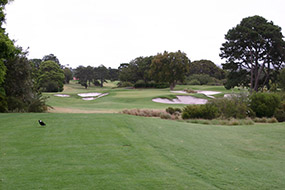The Royal Sydney Golf Club is a private members club. Visitors from Interstate or Overseas are welcome during certain periods of the week. Such visitors will need to be members of a recognised golf club, with a current membership identification card or a letter of introduction from the home club. Contact Planet Golf for assistance with tee times.
From an original base of twenty members in 1893, the Royal Sydney Golf Club has developed into the one of the largest sporting clubs in the world with its influential membership now totalling almost 6,000. Despite humble beginnings inland near the present Concord Golf Club, the club’s founders were determined to develop a seaside golf links and moved almost immediately to a new home in the Bondi sand hills with a plan to extend its nine hole course east toward the ocean. Sandhill encroachment however forced the club to instead gradually shuffle west across Old South Head Road, until the present site was acquired in 1909 and a new 18 hole course developed.
A product of slow meticulous evolution the golf course is devoid of the signature of any marquee designer and has instead matured through almost 100 years of sensible club management. Located on one of the most expensive pieces of Real Estate in the country, the billion dollar Rose Bay property is perfectly positioned a block from Sydney Harbour and a kilometre from the Pacific Ocean. The terrain is accordingly ideal for a links with the eastern side of the property elevated and tilted toward the centre of the course which, although narrow and much flatter, does not lack minor and interesting undulation. Two thirds of the course run North-South through this middle section yet pleasingly these holes are among Royal Sydney’s best.
The character of the golf course has developed from a classic links through periods of Parkland reform to the unique mix of both styles that members presently enjoy. During the 1960’s the club planted substantial amounts of trees and the feeling by the late 70’s was that the original links charm of Royal Sydney had been lost. As the cycle continued a large number of trees were then removed with the stunning final hole a vivid example of how the two styles were intertwined. The tee shot is played through a chute of mature gums to a dogleg where the trees end and a large open rolling green, framed by the magnificent clubhouse, is presented.
The front nine covers the more interesting terrain and opens with a clever short par four played from the shadows of the clubhouse and recently reshaped to incorporate a slight dogleg. The more difficult inward nine starts with back to back long par fours before moving to the tight mid length 12th with thick trees that narrow significantly the further you drive and a wonderful double green, built during the 1980’s. The finish to the round is particularly strong with a beautifully bunkered long hole, a tough par three and the brilliant 18th forming a superb closing stretch.
Originally the epitome of penal design there were at one stage as many as 350 bunkers dotted throughout the course, mostly lining the side of fairways. In 1926 Dr Alister MacKenzie recommended that to make the test more strategic as many as three-quarters could be removed describing the traps as being of little interest to golfers and ‘actually creating bad players owing to their cramping effect’. Despite a steep fee and high reputation, his recommendations were not implemented at the time, although gradually many of the bunkers that irked MacKenzie were removed.
In the late 1970’s, with the course in dire need of an upgrade, Peter Thomson and Michael Wolveridge were commissioned to improve greenside bunkering and reshape the greens with most built up to fall away into steep, closely mown hollows. By 2002 the club again felt the greens needed improvement and employed Ross Watson to reconstruct and slightly recontour all eighteen using a new fine leaf creeping Bentgrass it hoped would achieve a firmness, texture and speed similar to that experienced on Melbourne’s Sandbelt. As a consequence of firmer putting surfaces the bunker styling also needed attention and happily the larger classical bunkers that previously existed on holes 2 and 16, as remnants of a past era, became the model for the new work. Some additional bunkers were needed while existing traps were either rebuilt or reshaped to achieve a consistent style throughout.
Watson explains that ‘from an initial plan to replace the putting surfaces evolved a total facelift, the objective being to return the course to something like its former windswept rustic links feel as opposed to the parkland feel which had gradually taken over from the mid 1960's.’
Shifting from a penal to strategic design and from seaside to parkland and back again in appearance, Royal Sydney now strikes the better balance between a strong challenge to the better players and providing what MacKenzie refers to as 'pleasurable excitement' to its members and guests. It's not a great course, and some of the green contours feel a little contrived, but the conditioning is terrific and Watson's holes work well enough to satisfy most of the membership.
Melbourne Sandbelt and Australia's Best Private Courses
Play the legendary courses of the Melbourne Sandbelt, or the premier private clubs in Sydney and Adelaide.
MORE INFO
 this course also has exceptional:
this course also has exceptional:
